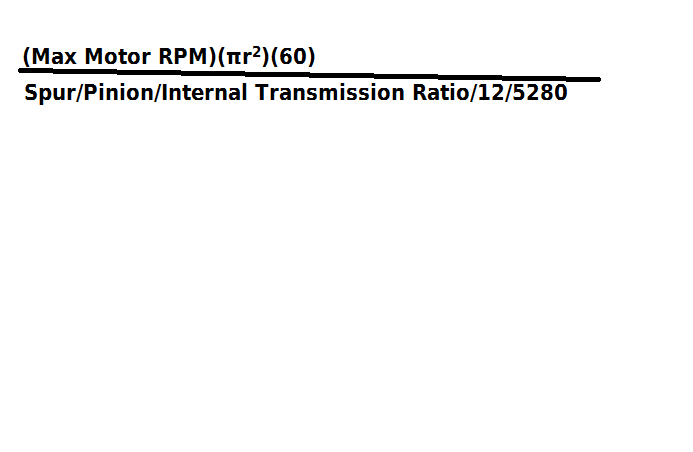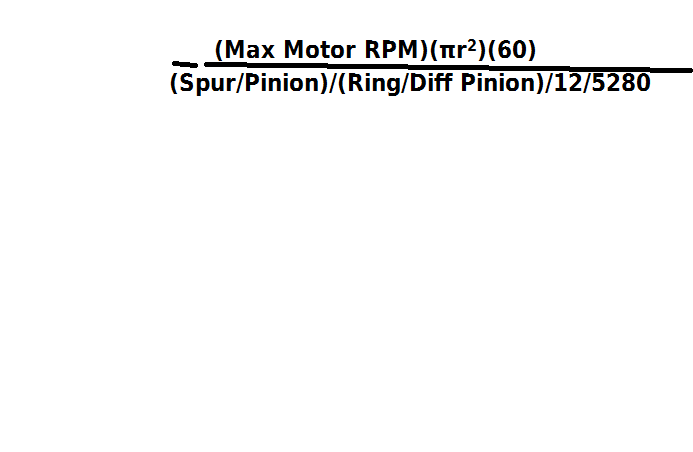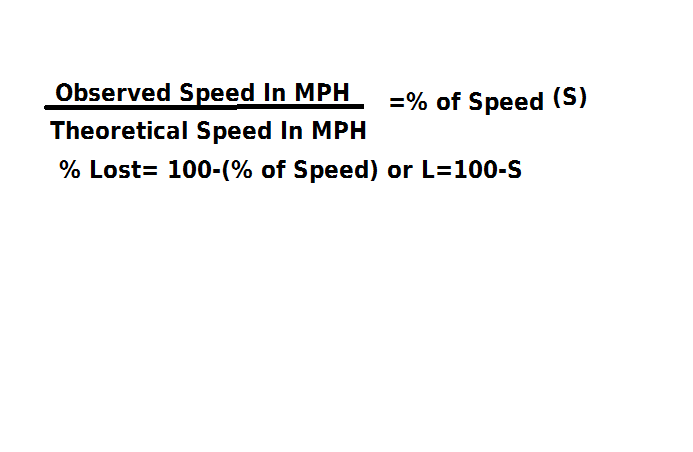Have you ever wondered what a difference a new pinion or a bigger battery will make in regards to top speed? Maybe you are looking to crack that elusive barrier of the next milestone MPH? Wouldn’t it be nice to find this information without spending your hard-earned cash on parts that may not give you the results you’re looking for? Using math can show you the results without spending a penny!
The formula for two-wheel-drive vehicles:

The formula for four-wheel-drive vehicles:

Now, these formulas will give you an “ideal” top speed for a given setup. These numbers do not take into account aerodynamic drag, tire expansion or frictional losses in the drivetrain, all of which will affect the real world numbers. What can be done to correct for this? Simple. Measure your car’s (or truck’s) top speed with its current setup and compare it to the number that the formula says. Divining the observed speed by the theoretical speed will give you the loss experienced due to the factors listed above.

Let’s say that your truck can only do 25 mph. but the formula says you should be able to reach 30.95, we can plug those numbers into the above formula to find the amount of drag the vehicle is experiencing. 25/30.95= .807 simplified to .81. This gives us the percentage as a decimal, converting that to a percentage is as simple as multiplying by 100. That gives us 81. 100-81=19. That’s a 19% loss in speed due to aerodynamic drag, friction, and other factors. Once you change the variable in the first equation to represent the change you want to make you can then apply the “frictional” correction to get an approximate calculation of the change.
For example:
A 3500kV motor on 2s, using a tire that is 4 inches in diameter (or a radius of 2 inches), running a 21t pinion and a 86t spur, in a Traxxas Slash with a transmission ratio of 2.76:1; seems like a lot of variables doesn’t it?
First lets determine the motor’s maximum RPM for a given voltage. At 3500kV (or RPM per volt) and a max battery voltage of 8.4 volts, gives a maximum RPM of 29,400. Next we have two options, multiply everything first and then divide that number by everything at once or take each step individually. I find it easier to multiply everything on the top of the equation then divide everything on the bottom.
(29,400)(pi(2)squared) where 2 is the radius of the tire. This is 369451.296. Multiply that by 60, which is 22167077.76. Divide this by the spur/pinion ratio which is (86/21) and you get 5413205.558. Divide this by the internal transmission ratio of 2.76 and you get 1961306.362. Divide this by 12, leaving 184725.647, Finally divide this number by 5280 and you get the theoretical top speed of 30.95 mph (rounded to the nearest hundredth).
Why did we multiply and divide all of these seemingly arbitrary numbers? It is a less-than-simple conversion from motor rpm to forward velocity. The 60 that is multiplied by on the top line converts the M (minutes) to H (hours). When dividing by 12 on the bottom, the inches that the tire’s radius is measured in is converted to feet and the 5,280 converts this number into miles.
As I said above, my preferred method is to multiply everything then divide everything. It is simpler for me to keep everything straight in my head. The answer comes out the same in the end but the steps are a little simpler. If doing it one step at a time, multiplying then dividing then multiplying again, (and repeating until the equation is completed) you would first take the motors RPM and divide it by the spur-pinion ratio; 29,400/(83/21)= 7179.487 which is the RPM at the top shaft of the transmission. Dividing this by the transmission ratio of 2.76 results in the RPM at the wheel, which is 2601.263 RPM. Converting this into distance traveled requires knowing the radius of the tire and using that number to find the distance the tire travels per revolution. The radius of a 4″ tall tire is 2 inches. Using the formula for circumference (pi(radius) squared) gives us 12.566, which is inches travel per revolution. Multiply that number by the rotations per minute (2601.263) and you get the distance traveled per minute, in inches, which is 32688.435. To convert to miles per hour takes a few steps. First, multiply the number by 60 (to convert the minutes to hours) which translates to 1961306.095. This gives us the inches per hour. The next step is to convert inches to feet by 12 to get the feet per hour (1961306.095/12= 163442.175, feet per hour). Dividing this number by 5280 converts feet to miles and gives us the final number of 30.95. Like I said, multiplying everything first then dividing is a simpler way to keep the numbers straight.
But wait, the truck only does 25 mph, what gives? This is where the third equation comes into play. Divide 25 by 30.95 and you get .807 which we’ll round up to .81 to keep things simple. This means you are achieving 81 percent of your truck’s speed potential, or losing 19% to friction and drag. Armed with that knowledge you can make decisions about what parts you need to reach your speed goals.
